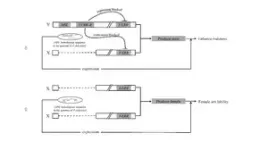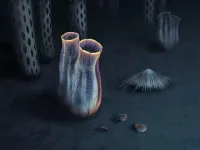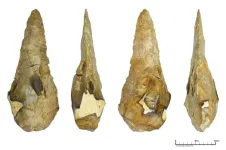(Press-News.org) A new study, published in PeerJ Life and Environment, conducted by Dr. Martina Lazzaroni (University of Veterinary Medicine, Vienna), Dr Joana Schar (University of Vienna) and colleagues, has shed light on the cognitive abilities of village dogs in understanding human communication. The research, which aimed to explore the impact of the domestication process on dogs' behavior and cognition, has yielded fascinating results, highlighting the importance of studying free-ranging dogs as representatives of the broader dog population.
Previous studies examining dogs' cognitive skills in understanding human communication primarily focused on pet dogs. While pet dogs serve as valuable models, they represent only a small fraction of the global dog population. In contrast, free-ranging dogs, who continue to experience selective forces of domestication, offer valuable insights into the evolutionary impact on dogs' behavior and cognition.
Despite the limited number of studies conducted on free-ranging dogs, particularly village dogs, the findings have been nothing short of intriguing. Researchers have discovered that village dogs exhibit a strong inclination towards social contact with humans and demonstrate an understanding of certain aspects of human communication.
In this recent study, researchers sought to explore the ability of village dogs to decipher subtle human communicative cues, specifically focusing on human facial expressions. To compare their findings with those of pet dogs, who have already exhibited evidence of this social skill, researchers conducted a test mimicking a real-life scenario.
During the experiment, the researchers repeatedly performed different facial expressions, such as neutral, happy, and angry, while in the presence of food. Eventually, the food was dropped on the ground. The results revealed that both village dogs and pet dogs were capable of distinguishing between subtle human communicative cues. Notably, the subjects exhibited a higher frequency of aversive gazes, such as looking away, in response to the angry facial expression compared to the happy expression.
However, the study did not yield other significant behavioral effects across the different conditions, likely due to the low intensity of the emotional expressions used. Nevertheless, researchers posit that village dogs' ability to discern human facial expressions could provide them with a survival advantage in human-dominated environments.
This research has opened new avenues of understanding regarding dogs' cognitive abilities and the effects of domestication on their behavior. By studying free-ranging dogs, scientists can gain valuable insights into the broader dog population's behavior and cognition, going beyond the limited scope of pet dogs.
These findings hold implications for various fields, including animal behavior, evolutionary biology, and human-animal interactions. The research team anticipates that further exploration of free-ranging dogs will contribute to our knowledge of the intricate relationship between humans and dogs, ultimately enhancing our understanding of animal cognition.
END
Village dogs match pet dogs in reading human facial expressions
2023-07-06
ELSE PRESS RELEASES FROM THIS DATE:
Rice U.’s Songtao Chen wins NSF CAREER Award
2023-07-06
HOUSTON – (July 6, 2023) – Songtao Chen, an assistant professor of electrical and computer engineering at Rice University, has won a prestigious National Science Foundation CAREER Award to advance the development of quantum networks by leveraging imperfections ⎯ known as point defects ⎯ in silicon material.
The grants are awarded each year to a selective cohort of about 500 early career faculty across all disciplines engaged in pathbreaking research and committed to growing their field through outreach and education.
Chen ...
Asian clams’ spread in Columbia River warns of worse invaders
2023-07-06
VANCOUVER, Wash. – The invasive Asian clam is more common in the lower Columbia River than its native habitat of southeast Asia, according to a study of the clam’s abundance in the river.
The findings don’t bode well for potential future invasions by the even more destructive quagga and zebra mussels. So far, the Columbia is one of the only major U.S. rivers to remain free of these notorious ecology-destroying, equipment-clogging bivalves.
To understand how new invaders might spread, a Washington State University-led ...
Discovery of 500-million-year-old fossil reveals astonishing secrets of tunicate origins
2023-07-06
Karma Nanglu says his favorite animal is whichever one he’s working on. But his latest subject may hold first place status for a while: a 500-million-year-old fossil from the wonderfully weird group of marine invertebrates, the tunicates.
“This animal is as exciting a discovery as some of the stuff I found when hanging off a cliffside of a mountain, or jumping out of a helicopter. It’s just as cool,” said Nanglu, postdoctoral researcher in the Department of Organismic and Evolutionary Biology at Harvard University.
In a new study in Nature Communications, Nanglu and coauthors describe the new fossil, ...
Researchers grow precise arrays of nanoLEDs
2023-07-06
Halide perovskites are a family of materials that have attracted attention for their superior optoelectronic properties and potential applications in devices such as high-performance solar cells, light-emitting diodes, and lasers.
These materials have largely been implemented into thin-film or micron-sized device applications. Precisely integrating these materials at the nanoscale could open up even more remarkable applications, like on-chip light sources, photodetectors, and memristors. However, achieving this integration has remained challenging because this delicate material can be damaged by conventional fabrication and patterning ...
Pathogens Portal: The new gateway to public pathogen data
2023-07-06
EMBL’s European Bioinformatics Institute (EMBL-EBI) has launched the Pathogens Portal – an online platform that enables researchers, clinicians, and policymakers to access the most comprehensive collection of biomolecular data about pathogens. The portal features data spanning over 200,000 pathogen species and strains and is set to become a key tool for infection biology and pathogen surveillance.
The list of pathogens featured in the portal was collated using the UK’s Health and Safety Executive’s ...
Stressed rattlesnakes found to calm down in the company of a nearby ‘friend’
2023-07-06
When animals suffer from acute or chronic stress, they produce more hormones causing shifts in the nervous system, immune response, and behavior. Some animals, if they are in the presence of a conspecific, can modulate their response to buffer stress. This is known as social buffering.
There is some research suggesting that snakes can exhibit complex social behavior. Nevertheless, social buffering in reptiles, as well as in other asocial organisms and solitary foragers, hasn’t been studied extensively. Now, researchers in the US have examined if rattlesnakes inhabiting Southern California use social buffering to alleviate acute stress.
“We showed that when ...
A first for UCLouvain in the fight against organ transplant rejection
2023-07-06
Every year in Belgium, 1,600 people wait for a transplant. Of these, in 2021, only 939 received an organ. Thus more than 40% of patients often have to wait more than a year before hoping to receive a transplant. When a transplant is possible, it is essential to ensure its success so as not to “waste” an organ. One of the keys to successful transplants is an anti-rejection drug, tacrolimus, which patients must take for life. But it is extremely difficult to dose this drug correctly, which can lead to significant risks of transplant failure in the event of underdosing and significant side effects in the event of overdosing (diabetes, hirsutism, hair loss, neuropathy or nephrotoxic ...
Giant stone artefacts found on rare Ice Age site in Kent
2023-07-06
UCL press release
Under embargo until Thursday, 6 July 2023, 00:01 London time
Giant stone artefacts found on rare Ice Age site in Kent
Researchers at the UCL Institute of Archaeology have discovered some of the largest early prehistoric stone tools in Britain.
The excavations, which took place in Kent and were commissioned in advance of development of the Maritime Academy School in Frindsbury, revealed prehistoric artefacts in deep Ice Age sediments preserved on a hillside above the Medway Valley.
The researchers, from UCL Archaeology South-East, discovered 800 stone artefacts thought to be over 300,000 years old, buried in sediments which filled a sinkhole and ...
New ferroelectric material could give robots muscles
2023-07-06
UNVERSITY PARK, Pa. — A new type of ferroelectric polymer that is exceptionally good at converting electrical energy into mechanical strain holds promise as a high-performance motion controller or “actuator” with great potential for applications in medical devices, advanced robotics, and precision positioning systems, according to a team of international researchers led by Penn State.
Mechanical strain, how a material changes shape when force is applied, is an important property for an actuator, which is any material that will change or deform when an external force such as electrical energy is applied. Traditionally, these actuator ...
CAMRE helps marines take 3D printing to new heights
2023-07-06
The Consortium for Additive Manufacturing Research and Education (CAMRE) at the Naval Postgraduate School (NPS) achieved the first successful demonstration of in-flight 3D printing aboard a U.S. Marine Corps MV-22 Osprey tiltrotor aircraft on June 21 in Southern California.
CAMRE’s operational demonstration, which involved the printing of a medical cast aboard an airborne Osprey, was part of larger-scale exercise support provided by CAMRE and the Marine Innovation Unit (MIU) to forces participating in an integrated training exercise (ITX) at Marine Corps Air Ground Combat Center Twentynine Palms, Calif., from June 10-22.
This successful test of in-flight ...








